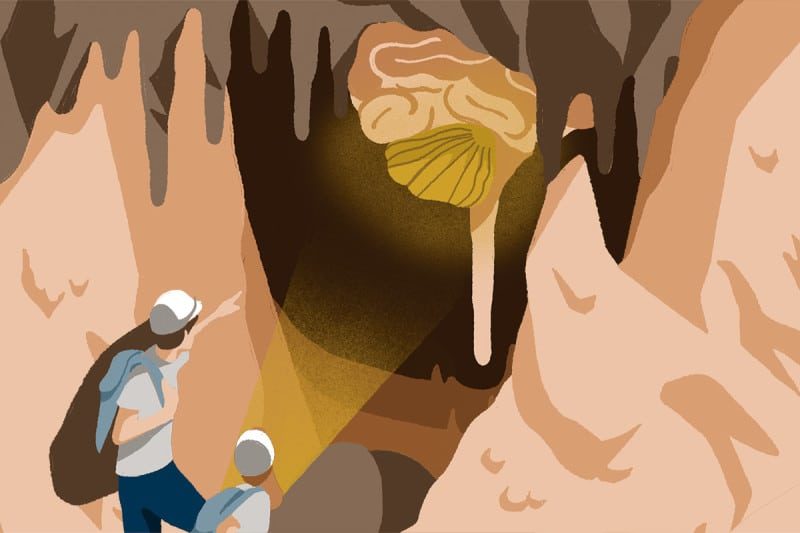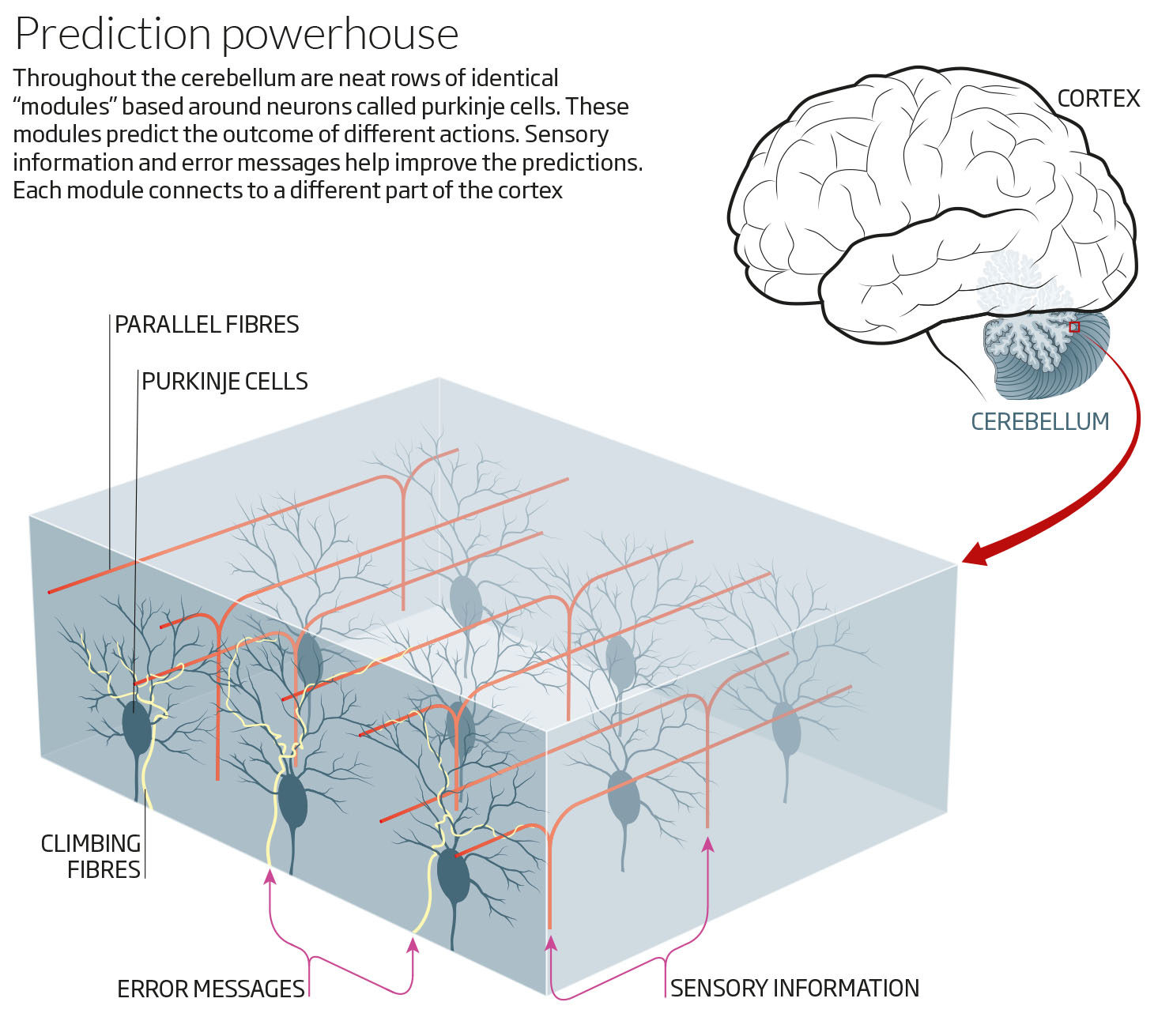
Recently, though, it has become clear that the cerebellum is far from a bit player in the story of humankind. Neuroscientists are starting to suspect that this little cauliflower-shaped orb at the back of our head, which is packed with more neurons than all the other brain regions put together and home to a superfast wiring system, is doing the kinds of complex calculations that allow for our most Sherlock-worthy feats. In fact, it could be the crowning achievement of our brain's evolution.
This upgrade in status has been a long time coming. In the 19th century, phrenologists, who looked at the shape of the skull to determine a person's character, declared the cerebellum, with its wrinkly lobes that hang from the bottom of the brain, the root of sexual desire. The larger the cerebellum, the greater the likelihood of sexual deviance.
The evidence soon began to suggest otherwise, however. During the first world war, the British neurologist Gordon Holmes noticed that the main problems for men whose cerebellums had been damaged by gunshot wounds had nothing to do with their sex lives and everything to do with the fine control of their movements, ranging from a lack of balance to difficulties with walking, speech and eye movements. From then on, the cerebellum became known as the mastermind of our smooth and effortless motions, with no role in thinking.
So entrenched was this idea that when brain imaging came along in the mid-1980s and researchers spotted activity in the cerebellum while people were lying still in a brain scanner and thinking, no one was quite sure what to make of it. This finding was mentioned in passing, says Robert Barton, an evolutionary neuroscientist at Durham University in the UK, or explained away as the neural signature of eye movements.
It was only in the 1990s that it became undeniable that something else was going on. Reports emerged describing people who had clear damage to their cerebellums but no trouble with movement. Instead they experienced a host of emotional and cognitive issues, from depression to attention problems and an inability to navigate.
In the loop
Around the same time, advances in neuroscience made it possible to trace long-range connections to and from the cerebellum. This revealed that only a small proportion of it is wired up to the motor cortex, the brain region involved in making deliberate movements, explaining why movement was unaffected for some people with a damaged cerebellum. In fact, the vast majority connects to regions of the cortex that are involved in cognition, perception, language and emotional processing.
A recent review of maps of the cerebellum built from functional MRI brain scans confirmed that all the major cortical regions have loops of connections running to and from the cerebellum. This has forced a major change in our understanding of how the cerebellum works. It turns out to be having private conversations with different areas of the cortex: taking information from them, transforming it and sending it back to where it came from.
It was a surprise to say the least. "This was Earth-shatteringly important because it totally transformed the way that we think about the cerebellum," says Narender Ramnani, a neuroscientist at Royal Holloway University in London. "We yank it out of the narrow world of motor control and give it a much more broad-ranging role in the control of all kinds of things."
One of the more unexpected connections was with the prefrontal cortex, which lies far from the cerebellum at the front of the brain and has long been considered the most advanced part of the organ. This is the region in charge of abilities considered to be uniquely human, such as planning, impulse control and emotional intelligence. It is disproportionately large and complex in humans compared with our closest relatives.
But then so is the cerebellum, says Barton. When he compared primate brains, he found there is something special about the ape cerebellum, particularly our own.
Throughout most of mammal evolution, the cerebellum increased in size at the same rate as the rest of the brain. But when the apes split off from other primates, something strange began to happen. The ape cerebellum had a runaway growth spurt, becoming disproportionately larger as it evolved in the lesser apes, the great apes and then humans.
In our own brains, the cerebellum is 31 per cent larger than you would expect from scaling up the brain of a non-ape primate. It is also jam-packed with brain cells, containing 16 billion more than you would anticipate finding if a monkey brain were enlarged to the size of ours. By strange coincidence, there are 16 billion neurons in the entire cortex. Neurons are particularly energy-hungry cells, so this represents a huge investment of resources of the kind the brain wouldn't bother with without good reason.
King of the swingers
Barton suspects that what started this unlikely growth spurt was the challenge of moving a much larger body through the trees. While small primates can run along the branches, even gibbon-sized apes are too heavy to do the same, at least without holding on to branches above. This led apes to make a switch to swinging through the branches, known as brachiation, which in turn made the ability to plan ahead a distinct advantage. "Brachiation is a relatively complex locomotor strategy," says Barton. "It involves fine sensory motor control, but it also involves a need to plan your route so that you can avoid accidents."
To truly be able to plan a route, it helps to be able to predict what is likely to happen next. And to do that, you need to make unconscious adjustments to the speed, strength and direction of your movements on the fly.
Neuroscientists believe that the cerebellum achieves this by computing the most likely outcome based on previous experience using so-called forward models. Once it has those models in place through learning, it can then update and amend them depending on what is happening now. "Forward models respond very quickly because they allow the brain to generate what are likely to be the correct movements without waiting around for feedback," says Ramnani.
Even so, the leap in motor skills that came with brachiation and forward planning doesn't completely explain the vast increase in the size of the cerebellum. But a closer look at its structure, and where it connects to, provides a few clues.
Compared with the rest of the brain, the cerebellum is remarkably neat and tidy. Vineyard-like rows of bushy neurons called purkinje cells are linked by parallel fibres coming from the senses and vertical climbing fibres, which are thought to carry error messages with which to update the internal models (see below).
This structure is copied and pasted across the entire cerebellum, with processing units set up like banks of computers, spitting out predictions all day long. So, unlike the cortex, the structure of the cerebellum looks exactly the same regardless of where you look or which part of the cortex it is connected to. The only distinction is that different "modules" connect to different parts of the cortex.
This suggests that whatever kind of computation the cerebellum is carrying out for the motor regions of the brain, it is likely to be doing much the same for the cognitive and emotional regions too, says Ramnani. And if the cerebellum is learning to automate rules for movements, it is probably doing likewise for social and emotional interactions, which it can call up, adapt and use at lightning speed.
Having the ability to learn, plan, predict and update was, Barton believes, a key moment in our evolution, opening up a whole new world of complex behaviours. At first, these behaviours revolved around planning sequential movements to reach a goal, such as adapting a twig as a tool for termite fishing. But, eventually, thinking unhooked from movement, allowing us to plan our behaviours without moving a muscle. Barton thinks that being able to understand sequences could have allowed our ancestors to decode the gestures of others, for instance, setting the stage for the development of language.
"It could be responsible for our greatest achievements like science and culture"
Catherine Stoodley, who studies the cerebellum at the American University in Washington DC, agrees. Once you have the general concept that "this happens, and then that happens", she says, it can be used for all kinds of things. Everything from making a cup of tea to planning for your retirement requires the ability to understand that things happen in a particular order. Ultimately, our beefed-up cerebellum might be behind all kinds of skills that we have always thanked our cortex for. With this new ability for forward planning and complex thinking, some even claim the cerebellum is behind our greatest achievements like science and culture.
The cerebellum's complex role in the way we think could have implications if it goes awry (see "Little brain, big impact"). And the idea that the cerebellum makes and updates forward models also chimes with a recent shift in our wider understanding of how the brain builds a picture of the world around us. According to this, the brain makes sense of the cacophony of sensory information it is bombarded with by using past experience to make predictions that it updates as it goes along. With its forward planning capabilities, the cerebellum may play a more important role in the general workings of the brain than we thought, says Andy Clark, a philosopher at the University of Edinburgh in the UK.
"Movement, language and thought need to be able to work together seamlessly as we go about our daily tasks," says Clark. "The cerebellum seems well placed, and well wired, to act as a pivotal node in that essential dance."
Much of this fine-tuning takes place unconsciously, which could make the cerebellum a key hub that helps us to meld unconscious knowledge with our conscious experience. Once we have learned the finer details of social and perceptual rules, for example, we can delegate that processing to the cerebellum, and use our precious resources elsewhere in the brain for something that needs our full attention.
This means that we don't have to expend much energy processing subtle social cues, or working out how to respond to the scene in front of us. Instead, we apply rules we have already learned, and only look at them afresh if something unexpected happens. In short, the cerebellum is automatic thinking, outsourced to the experts. "We've got a limited capacity, but often need to do many things at once. So how do we deal with that? Well you bolt a cerebellum onto the back of that system," says Ramnani.
It may be early days in our understanding of the cerebellum, but given we can now see how important it is not just for movement, but also for complex thought, Stoodley thinks it could help us reassess how we define thought itself - to consider it as a kind of movement that got trapped inside the brain. "At what point is the planning process part of cognition or part of movement?" says Stoodley. "In some ways, that cut-off is arbitrary."
So as you try and wrap your head around that one, you can thank your cerebellum.
Little brain, big impact
We used to think of the cerebellum as playing a key role solely in movement, but the latest thinking suggests it is involved in everything from planning to social interactions. This new way of thinking means it could have a role in a range of conditions. For instance, differences in how the cerebellum and the prefrontal cortex are connected are thought to affect the ability of people with ADHD to focus.
Schizophrenia, too, is commonly linked with cerebellum changes, which could result in an inability to balance internally generated models of reality with sensory information entering the brain.
There is some hope that giving the cerebellum a boost using a type of brain stimulation called transcranial magnetic stimulation could help. A clinical trial is under way for schizophrenia.
This stimulation could even do us all some good: a recent study found that applying it to the cerebellum of healthy volunteers improved their ability to sustain attention.





Reader Comments
to our Newsletter